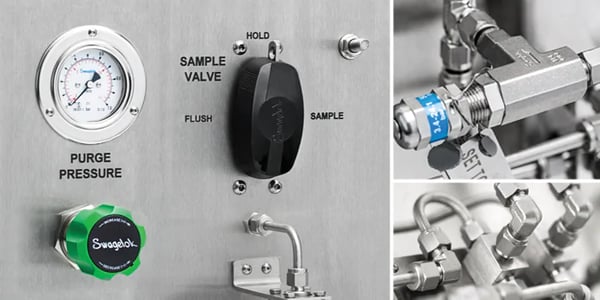Share this
Is Your Dead Leg Piping Inspection Optimized?
by Morgan Zealear on 1/21/21 8:45 AM
.jpg?width=500&name=shutterstock_254299267%20(1).jpg)
A dead leg is a section of piping or tubing that poses the risk of storing old samples that contaminate later samples. These can be pipes closed by welded caps, flanges, or shut-off valves, or simply instrument ports or poor plumbing design practices. It can also describe piping components that have no significant flow. Throughout a refinery, especially those that have been operating for decades, you’re likely to find a multitude of dead legs. They’re found in high-point vents, drains, bypass piping, instrument connections, and grab sampling points.
.jpg?width=600&name=shutterstock_280686326%20(1).jpg)
Dead Legs Are Inherently Problematic
Dead legs are inherently problematic. Because of their intermittent usage or stagnant fluid in these piping sections, they’re prone to contamination and corrosion at rates significantly higher than piping where fluids flow freely. The degree and rate of corrosion in dead legs are affected by the fluid, wall thickness, dead leg orientation, and overall configuration of the piping section. In some of the worst cases, pipe wall corrosion rates greater than 2mm per year have been reported. In any refinery, failure to recognize these problems is a recipe for disaster. Here in the Bay Area, the consequences are all the greater because of Cal/OSHA and/or BAAQMD regulations.
Dead leg corrosion can also be problematic in poorly-designed grab sampling systems. Without the proper pre-sampling purge or use of a fast loop design, dead leg corrosion can contaminate fluid samples. If corrosion isn’t a problem, a dead leg can nonetheless render inaccurate samples.
The Challenge of Dead Leg Piping Inspections in a Refinery
Management of dead legs in a refinery is a significant challenge simply because of their number. To effectively monitor and mitigate problems associated with dead legs, you need a carefully planned and executed dead leg piping inspection program.
An enterprise asset management system such as Maximo, SAP EAM, or Infor CloudSuite EAM plays a vital role in managing the dead leg piping inspections. Details regarding locations of piping, configuration specifications, and inspection data are easily managed in these systems to record dead leg inspection schedules, inspection results, and maintenance activities.
A Prioritized List of Refinery Dead Legs Determines Inspection Schedule
With an EAM system, maintenance and operations engineers can query the database regarding dead leg types, locations, and processes. The goal of the analysis is to prioritize and schedule inspections based on risk and criticality of pipe failure caused by corrosion. The initial analysis will factor in pipe or tubing materials, wall thickness, and estimated deterioration rates based on maintenance records.
The results of your analysis should result in a prioritized list of dead legs and a preliminary dead leg piping inspection schedule, based on criticality and maintenance records. Piping location, materials, and dimensions will determine the actual inspection method. Ultrasonic phased array scans or eddy current testing are the most common methods of detecting deterioration caused by corrosion in pipe or tubing walls.
Redesign or Replace to Reduce the Need for Inspections
Regularly scheduled inspections and recording of the results will highlight conditions that require special attention. In many cases, the best option may be a redesign and replacement of the piping. Newer materials and different piping configurations can significantly mitigate corrosion problems and reduce the frequency of dead leg piping inspections. In many cases, reconfigured piping can eliminate the dead leg and the need for inspection.
In the case of dead legs associated with grab sampling systems, eliminating problems with dead legs can be significantly easier and less costly than large diameter piping replacement or reconfiguration. Field engineers from Swagelok can work with you on-site to review grab sampling stations based on data in your EAM, identify problematic stations, and propose designs that significantly reduce or eliminate the risk of contamination by corrosion. Location of sampling tap, tubing materials, geometry, length of tubing runs, fittings, instrumentation, and pre- or post-sampling purge processes are a few of the critical factors that contribute to better design.

With an improved grab sampling design, you’ll significantly reduce the probability of corrosion that contaminates samples as well as reduce dead leg piping inspection frequency for those systems. An investment in an upgraded grab sampling design can realize a quick return on investment by reducing the need for inspections and ensuring accurate, representative samples over the life of the system.
The Best Way to Optimize Dead Leg Piping Inspections
The number of dead legs found throughout a refinery presents a major challenge to refinery operations groups as they attempt to maintain safe, reliable production processes. With the aid of enterprise asset management software, maintenance engineers can identify and prioritize dead leg locations that present significant risk and work with process engineers to reduce or eliminate those risks via better piping designs.
You can also apply the same approach to problematic grab sampling stations, working closely with experienced field engineers from Swagelok to redesign or replace them to virtually eliminate corrosion risks and improve sampling quality and consistency.
Dead leg piping inspections are a critical aspect of maintaining safe, reliable refinery processes. With the number of dead legs in any refinery, any steps taken to eliminate them or replace them with better designs improve operational efficiency and optimize the inspection process.
To learn how Swagelok Northern California can help you eliminate or mitigate problems associated with dead legs in grab sampling systems with the expertise and guidance of experienced field engineers, contact our team today by calling 510-933-6200.
 Morgan Zealear | Product Engineer – Assembly Services
Morgan Zealear | Product Engineer – Assembly Services
Morgan holds a B.S. in Mechanical Engineering from the University of California at Santa Barbara. He is certified in Section IX, Grab Sample Panel Configuration, and Mechanical Efficiency Program Specification (API 682). He is also well-versed in B31.3 Process Piping Code. Before joining Swagelok Northern California, he was a Manufacturing Engineer at Sierra Instruments, primarily focused on capillary thermal meters for the semiconductor industry (ASML).
Share this
- Archive (465)
- Assembly Services (207)
- About (100)
- Seal Support Systems (96)
- Best Practices (88)
- Training Services (74)
- Fittings (51)
- Semiconductor Applications (49)
- Hoses and Flexible Tubing (47)
- Regulators (44)
- Tubing (42)
- Grab Sampling Systems (32)
- Sampling Systems (32)
- Gas Systems (30)
- Services (30)
- Downloads (29)
- Valves (24)
- Application Support (18)
- Orbital Welding (17)
- Case Studies (13)
- Steam Systems (13)
- Frequently Asked Questions (12)
- Tools (12)
- Measurement Devices (7)
- Subsystems (6)
- Thermal Management (6)
- September 2023 (1)
- August 2023 (2)
- June 2023 (1)
- March 2023 (3)
- February 2023 (3)
- January 2023 (4)
- December 2022 (4)
- November 2022 (4)
- October 2022 (4)
- September 2022 (1)
- August 2022 (3)
- July 2022 (2)
- June 2022 (4)
- May 2022 (1)
- April 2022 (2)
- March 2022 (1)
- February 2022 (2)
- January 2022 (3)
- December 2021 (1)
- November 2021 (6)
- October 2021 (6)
- September 2021 (8)
- August 2021 (4)
- July 2021 (3)
- June 2021 (6)
- May 2021 (6)
- April 2021 (7)
- March 2021 (5)
- February 2021 (4)
- January 2021 (6)
- December 2020 (5)
- November 2020 (6)
- October 2020 (6)
- September 2020 (8)
- August 2020 (7)
- July 2020 (8)
- June 2020 (8)
- May 2020 (6)
- April 2020 (9)
- March 2020 (7)
- February 2020 (10)
- January 2020 (21)
- December 2019 (23)
- November 2019 (21)
- October 2019 (22)
- September 2019 (21)
- August 2019 (22)
- July 2019 (23)
- June 2019 (20)
- May 2019 (23)
- April 2019 (22)
- March 2019 (21)
- February 2019 (20)
- January 2019 (21)
- December 2018 (14)
- November 2018 (19)
- October 2018 (23)
- September 2018 (17)
- August 2018 (29)
- July 2018 (11)
- June 2018 (6)
- May 2018 (5)
- April 2018 (4)
- March 2018 (5)
- February 2018 (3)
- January 2018 (3)
- December 2017 (2)
- November 2017 (4)
- October 2017 (3)
- September 2017 (2)
- August 2017 (6)
- July 2017 (4)
- June 2017 (4)
- May 2017 (4)
- April 2017 (3)
- March 2017 (4)
- February 2017 (3)
- January 2017 (3)
- December 2016 (3)
- November 2016 (3)
- October 2016 (3)
- September 2016 (5)
- August 2016 (5)
- July 2016 (4)
- June 2016 (5)
- May 2016 (3)
- April 2016 (4)
- March 2016 (5)
- February 2016 (11)
- January 2016 (1)
- December 2015 (3)
- November 2015 (4)
- October 2015 (3)
- September 2015 (4)
- August 2015 (4)
- July 2015 (8)
- June 2015 (5)
- May 2015 (3)
- April 2015 (4)
- March 2015 (4)
- February 2015 (3)
- January 2015 (4)
- December 2014 (2)
- November 2014 (3)
- October 2014 (4)
- September 2014 (4)
- August 2014 (4)
- July 2014 (5)
- June 2014 (4)
- May 2014 (4)
- April 2014 (5)
- March 2014 (4)
- February 2014 (3)
- January 2014 (4)
- December 2013 (5)
- November 2013 (3)
- October 2013 (4)
- September 2013 (3)
- August 2013 (5)
- July 2013 (5)
- June 2013 (5)
- May 2013 (3)
- April 2013 (6)
- March 2013 (4)
- February 2013 (4)
- January 2013 (8)
- December 2012 (4)
- November 2012 (6)
- October 2012 (6)
- September 2012 (4)
- August 2012 (4)
- July 2012 (4)
- June 2012 (4)

.webp?width=210&height=70&name=StickyLogo%20(5).webp)